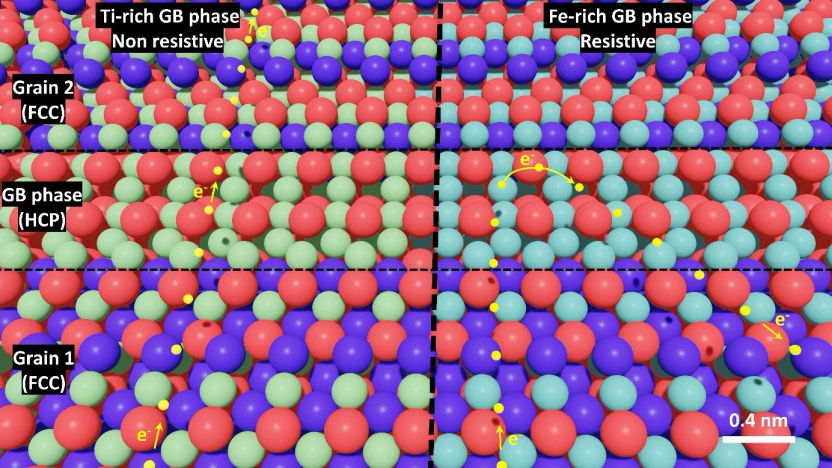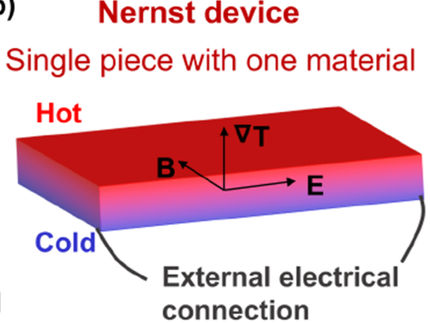Tuning thermoelectric materials for efficient power generation
Advertisement
How to make energy conversion more efficient and use waste heat for electricity? Researchers of the Max-Planck-Institut für Eisenforschung tuned the microstructure of thermoelectric materials by doping the grain boundaries with titanium. This way they were able to achieve optimal low thermal and high electrical conductivity.

The chemistry and atomic arrangement of the grain boundary phases define the electron transport through the grain boundaries. The titanium-rich grain boundary phase provides a conductive path (left) while the iron-rich grain boundary phase is resistive to electrons (right).
© R. Bueno Villoro, Max-Planck-Institut für Eisenforschung GmbH
In times where energy is scarce and sustainable ways of energy production are being explored, thermoelectric materials are considered for power generation to transform waste heat into electricity. However, to make this transformation more efficient, thus usable on an industrial scale, a better understanding of the functional and structural properties of the materials is needed. A researcher team led by the Max-Planck-Institut für Eisenforschung (MPIE) was now able to tune the microstructure of a promising new thermoelectric material for efficient energy conversion. The team published their results in the journal Advanced Energy Materials.
Tuning thermoelectric properties through grain boundary engineering
Previous research has shown that the structure and composition of grain boundaries are crucial for the thermal and electrical conductivity of thermoelectric materials. Usually, grain boundaries reduce both the thermal and electrical conductivity of the material while it is desirable to have a low thermal, but a high electrical conductivity. The aim of the researchers from MPIE, the Northwestern University (USA) and the Leibniz Institute for Solid State and Materials Research Dresden (Germany) was to modify the grain boundaries so that only thermal conductivity is reduced, while their electrical conductivity remains high. They used a Ti-doped NbFeSb half-Heusler intermetallic compound – a recently developed, but promising thermoelectric alloy. It has excellent thermoelectric properties at mid to high temperatures, a good thermal and mechanical robustness and its elements are earth-abundant and benign.
“We used advanced characterization techniques like scanning transmission electron microscopy and atom probe tomography to unveil the microstructure of the alloys down to the atomic scale. Our analysis showed that the chemistry and atomic arrangement of the grain boundaries can be tuned to engineer the electronic and thermal transport properties”, says Ruben Bueno Villoro, doctoral researcher in the independent research group “Nanoanalytics and Interfaces” at MPIE and first author of the publication. As the grain size is small, the increased number of grain boundaries significantly reduces the electrical conductivity. “By doping the alloy with titanium, we found that grain boundaries become titanium-rich and no longer resistive, so that we can fully utilize the beneficial low thermal conductivity provided by the small grain size”, explains Dr. Siyuan Zhang, project leader in the same research group and corresponding author of the publication.
Next step: selective doping of grain boundaries
After demonstrating the strategy of grain boundary engineering, the researchers are exploring new ways to selectively dope the grain boundaries. By relating functional properties to the atomic structures of critical microstructure features such as grain boundaries, the researcher team is developing new design principles for materials critical to a sustainable future.
Original publication
R. Bueno Villoro, D. Zavanelli, C. Jung, D.A. Mattlat, R. Hatami Naderloo, N. Pérez, K. Nielsch, G.J. Snyder, C. Scheu, R. He, S. Zhang: Grain boundary phases in NbFeSb half-Heusler alloys: A new avenue to tune transport properties of thermoelectric materials. In: Advanced Energy Materials (2023) 2204321.

































































